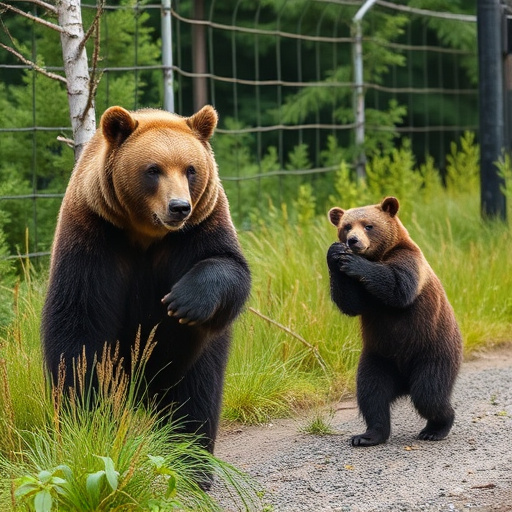Knowing wind direction is crucial for using bear spray effectively against grizzlies. Keep bear spray accessible, inspect it regularly, and use it strategically by aiming at the bear's face when the wind is behind you. Position yourself downwind from food sources to avoid attracting bears in wilderness areas. Stay calm, maintain eye contact, and protect yourself with proper gear for safe coexistence with these powerful animals.
In the vast wilderness, encountering a charging grizzly bear is a stark reality. Understanding these formidable predators’ behavior and habitat is crucial for safety. This article equips readers with essential knowledge on navigating high-risk areas, including assessing wind direction for bear spray effectiveness. We delve into the proper use and range of bear spray, along with additional safety measures to enhance survival chances in wilderness settings, emphasizing the importance of wind direction for optimal protection.
- Understanding Grizzly Bear Behavior and Habitat
- Assessing Wind Direction for Bear Spray Effectiveness
- Proper Use and Range of Bear Spray
- Additional Safety Measures in Wilderness Settings
Understanding Grizzly Bear Behavior and Habitat
Grizzly bears, or Ursus arctos horribilis, are iconic symbols of North America’s wilderness. Understanding their behavior and habitat is crucial for anyone venturing into bear country. These powerful animals are primarily solitary and highly intelligent, with a strong sense of smell—they can detect food from great distances. Their habitats often include dense forests, alpine meadows, and river valleys, where they feed on salmon, berries, and roots.
Knowing the wind direction is vital for safety; bears have an excellent sense of smell, and carrying bear spray is recommended. When hiking or camping in bear country, always stay alert and make noise to avoid unexpected encounters. Understanding these behaviors enables hikers and outdoor enthusiasts to take proactive measures, ensuring a safer experience in the great wilderness while coexisting with these magnificent creatures.
Assessing Wind Direction for Bear Spray Effectiveness
Understanding wind direction is a crucial aspect of bear spray safety when venturing into the wilderness. Bear spray, an essential defense mechanism against aggressive grizzlies, relies on proper application and timing. The key lies in assessing whether the wind is blowing towards you or away from you. If the wind is at your back, you have a strategic advantage as the spray can reach the bear effectively, covering its sensitive areas and temporarily incapacitating it. Conversely, when the wind blows against you, the bear spray may not reach the bear, rendering it less effective.
Knowing this, hikers and outdoor enthusiasts can make informed decisions about their positioning relative to potential bear encounters. By being mindful of wind direction, individuals can maximize the potency of bear spray, ensuring a safer experience in grizzly bear country.
Proper Use and Range of Bear Spray
Bear spray is a crucial tool for defending against charging grizzlies, but its proper use and understanding are essential for maximum effectiveness. When encountering a bear, it’s vital to assess the wind direction before deploying any defense mechanism. Aiming bear spray directly at the bear, with the can upright and facing towards the animal, ensures the spray reaches the intended target. The range of bear spray varies depending on factors like air density, temperature, and spray technique, but generally, it can reach up to 30 feet (9 meters).
Knowing when and how to use bear spray is key to your safety in grizzly country. Always keep the can in an easily accessible position, such as a belt pouch or backpack side pocket. When faced with an attack, stay calm, point the spray towards the charging bear’s face and eyes, and pull the trigger while maintaining eye contact. Remember, early detection, staying calm, and carrying the right gear, including bear spray, are vital components of grizzly bear defense strategies.
Additional Safety Measures in Wilderness Settings
In wilderness settings, understanding the wind direction is a crucial safety measure. Bears have an exceptional sense of smell, and they can detect food or potential threats from miles away. Knowing which way the wind is blowing allows campers to position themselves accordingly, ensuring they’re not facing into the bear’s scent drift. For instance, setting up camp downwind from likely sources of food or refuse will minimize the risk of attracting bears.
One of the most effective tools in defending against charging grizzly bears is bear spray. This pyrotechnic device projects a cloud of pepper spray that can deter a bear at close range. Proper usage requires understanding the wind direction to ensure the spray reaches the bear and doesn’t blow back onto the user. Always keep bear spray easily accessible, regularly inspect it for damage or expiration, and familiarize yourself with the instructions before venturing into bear country.
When venturing into wilderness areas known for grizzly bear habitats, understanding bear behavior, assessing wind direction for optimal bear spray effectiveness, and adhering to proper usage guidelines are paramount. Additionally, implementing other safety measures like making noise to deter bears and securing food properly can significantly enhance your safety. By combining these strategies, you can navigate the outdoors with greater confidence and peace of mind, ensuring a safer experience in bear country.
